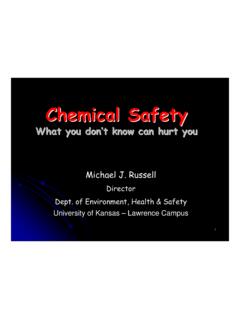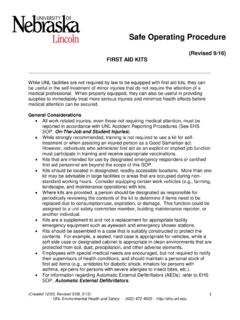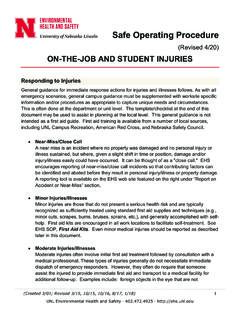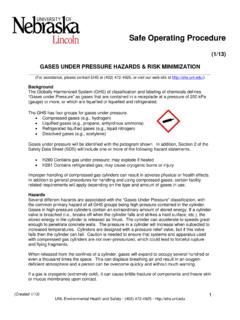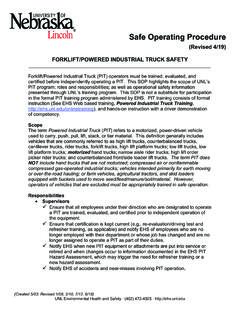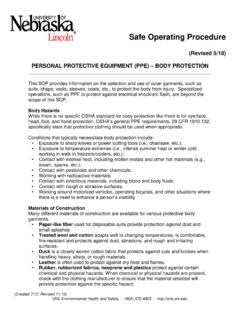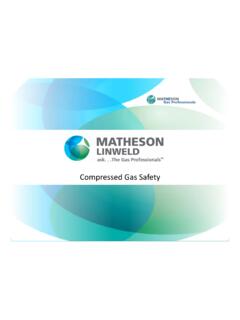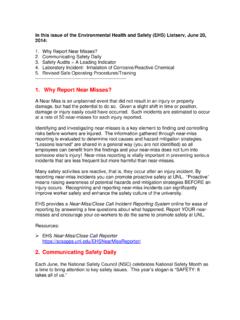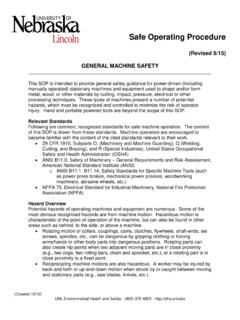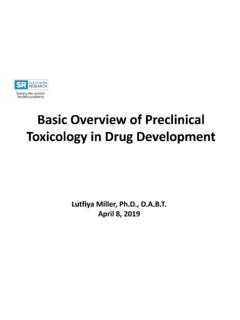Transcription of Toxicology and Exposure Guidelines
1 (Created 12/02) UNL Environmental Health and Safety (402) 472-4925 (Revised 1/03) Toxicology AND Exposure Guidelines _____ (For assistance, please contact EHS at (402) 472-4925, or visit our web site at ) "All substances are poisons; there is none which is not a poison. The right dose differentiates a poison and a remedy." This early observation concerning the toxicity of chemicals was made by Paracelsus (1493-1541). The classic connotation of Toxicology was "the science of poisons." Since that time, the science has expanded to encompass several disciplines. Toxicology is the study of the interaction between chemical agents and biological systems. While the subject of Toxicology is quite complex, it is necessary to understand the basic concepts in order to make logical decisions concerning the protection of personnel from toxic injuries.
2 Toxicity can be defined as the relative ability of a substance to cause adverse effects in living organisms. This "relative ability is dependent upon several conditions. As Paracelsus suggests, the quantity or the dose of the substance determines whether the effects of the chemical are toxic, nontoxic or beneficial. In addition to dose, other factors may also influence the toxicity of the compound such as the route of entry, duration and frequency of Exposure , variations between different species (interspecies) and variations among members of the same species (intraspecies). To apply these principles to hazardous materials response, the routes by which chemicals enter the human body will be considered first. Knowledge of these routes will support the selection of personal protective equipment and the development of safety plans.
3 The second section deals with dose-response relationships. Since dose-response information is available in Toxicology and chemistry reference books, it is useful to understand the relevance of these values to the concentrations that are actually measured in the environment. The third section of this chapter includes the effects of the duration and frequency of Exposure , interspecies variation and intraspecies variation on toxicity. Finally, toxic responses associated with chemical exposures are described according to each organ system. Routes of Exposure There are four routes by which a substance can enter the body: inhalation, skin (or eye) absorption, ingestion, and injection. Inhalation: For most chemicals in the form of vapors, gases, mists, or particulates, inhalation is the major route of entry.
4 Once inhaled, chemicals are either exhaled or deposited in the respiratory tract. If deposited, damage can occur through direct contact with tissue or the chemical may diffuse into the blood through the lung-blood interface. Upon contact with tissue in the upper respiratory tract or lungs, chemicals may cause health effects ranging from simple irritation to severe tissue destruction. Substances absorbed into the blood are circulated and distributed to organs that have an affinity for (Created 12/02) UNL Environmental Health and Safety (402) 472-4925 that particular chemical . Health effects can then occur in the organs, which are sensitive to the toxicant. Skin (or eye) absorption: Skin (dermal) contact can cause effects that are relatively innocuous such as redness or mild dermatitis; more severe effects include destruction of skin tissue or other debilitating conditions.
5 Many chemicals can also cross the skin barrier and be absorbed into the blood system. Once absorbed, they may produce systemic damage to internal organs. The eyes are particularly sensitive to chemicals. Even a short Exposure can cause severe effects to the eyes or the substance can be absorbed through the eyes and be transported to other parts of the body causing harmful effects. Ingestion: Chemicals that inadvertently get into the mouth and are swallowed do not generally harm the gastrointestinal tract itself unless they are irritating or corrosive. Chemicals that are insoluble in the fluids of the gastrointestinal tract (stomach, small, and large intestines) are generally excreted. Others that are soluble are absorbed through the lining of the gastrointestinal tract.
6 They are then transported by the blood to internal organs where they can cause damage. Injection: Substances may enter the body if the skin is penetrated or punctured by contaminated objects. Effects can then occur as the substance is circulated in the blood and deposited in the target organs. Once the chemical is absorbed into the body, three other processes are possible: metabolism, storage, and excretion. Many chemicals are metabolized or transformed via chemical reactions in the body. In some cases, chemicals are distributed and stored in specific organs. Storage may reduce metabolism and therefore, increase the persistence of the chemicals in the body. The various excretory mechanisms (exhaled breath, perspiration, urine, feces, or detoxification) rid the body, over a period of time, of the chemical .
7 For some chemicals elimination may be a matter of days or months; for others, the elimination rate is so low that they may persist in the body for a lifetime and cause deleterious effects. The Dose-Response Relationship In general, a given amount of a toxic agent will elicit a given type and intensity of response. The dose-response relationship is a fundamental concept in Toxicology and the basis for measurement of the relative harmfulness of a chemical . A dose-response relationship is defined as a consistent mathematical and biologically plausible correlation between the number of individuals responding and a given dose over an Exposure period. Dose Terms. In Toxicology , studies of the dose given to test organisms is expressed in terms of the quantity administered: Quantity per unit mass (or weight).
8 Usually expressed as milligram per kilogram of body weight (mg/kg). Quantity per unit area of skin surface. Usually expressed as milligram per square centimeter (mg/cm2). Volume of substance in air per unit volume of air. Usually given as microliters of vapor or gas per liter of air by volume (ppm). Particulates and gases are also given as milligrams of material per cubic meter of air (mg/m3). (Created 12/02) UNL Environmental Health and Safety (402) 472-4925 The period of time over which a dose has been administered is generally specified. For example, 5 mg/kg/3 D is 5 milligrams of chemical per kilogram of the subject's body weight administered over a period of three days. For dose to be meaningful it must be related to the effect it causes. For example, 50 mg/kg of chemical "X" administered orally to female rats has no relevancy unless the effect of the dose, say sterility in all test subjects, is reported.
9 Dose-Response Curves. A dose-response relationship is represented by a dose-response curve. The curve is generated by plotting the dose of the chemical versus the response in the test population. There are a number of ways to present this data. One of the more common methods for presenting the dose-response curve is shown in Graph 1. In this example, the dose is expressed in "mg/kg" and depicted on the "x" axis. The response is expressed as a "cumulative percentage" of animals in the test population that exhibits the specific health effect under study. Values for "cumulative percentage" are indicated on the "y" axis of the graph. As the dose increases, the percentage of the affected population increases. Dose-response curves provide valuable information regarding the potency of the compound.
10 The curves are also used to determine the dose-response terms that are discussed in the following section. Graph 1 Hypothetical Dose-Response Curve Dose-Response Terms. The National Institute for Occupational Safety and Health (NIOSH) defines a number of general dose-response terms in the "Registry of Toxic Substances" (1983, p. xxxii). A summary of these terms is contained in Table 1. Toxic dose low (TDLO): The lowest dose of a substance introduced by any route, other than inhalation, over any given period of time, and reported to produce any toxic effect in humans or to produce tumorigenic or reproductive effects in animals. Toxic concentration low (TCLO): The lowest concentration of a substance in air to which humans or animals have been exposed for any given period of time that has (Created 12/02) UNL Environmental Health and Safety (402) 472-4925 produced any toxic effect in humans or produced tumorigenic or reproductive effects in animals.
